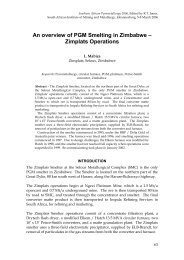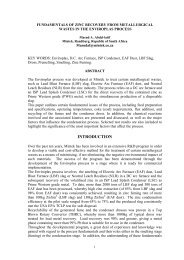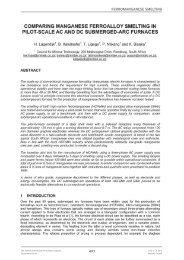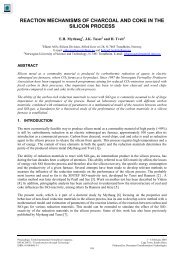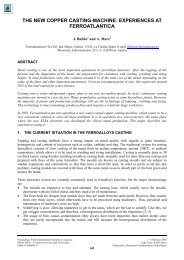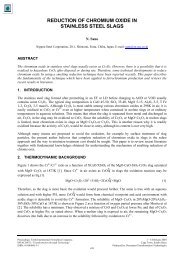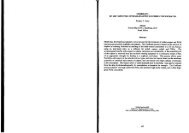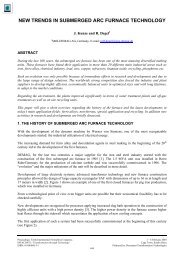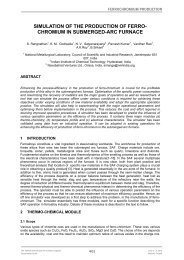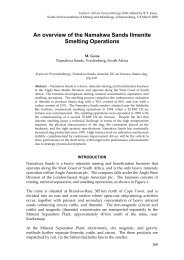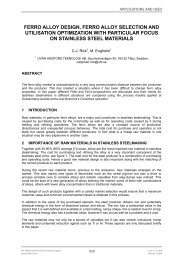air pollution control system upgrade at tubatse ... - Pyro.co.za
air pollution control system upgrade at tubatse ... - Pyro.co.za
air pollution control system upgrade at tubatse ... - Pyro.co.za
You also want an ePaper? Increase the reach of your titles
YUMPU automatically turns print PDFs into web optimized ePapers that Google loves.
Air Pollution Control System Upgrade <strong>at</strong> Tub<strong>at</strong>se Ferrochrome 437on reducing emissions from Ferroalloy furnaces and i.a. established required SE values for various feed m<strong>at</strong>erialprepar<strong>at</strong>ion regimes.A more sophistic<strong>at</strong>ed method of sizing baghouse equipment is based on furnace he<strong>at</strong> extraction requirements– sometimes referred to as the “X” factor. Ac<strong>co</strong>rding to this method, the he<strong>at</strong> <strong>co</strong>ntent of the submergedarc furnace exhaust gas is directly proportional to the furnace load (influenced by the amount and type of rawm<strong>at</strong>erials and furnace oper<strong>at</strong>ion). The r<strong>at</strong>io of Exhaust Gas He<strong>at</strong> to Furnace Power input yields the “X” factor.Therefore, the rel<strong>at</strong>ionship can be written as follows:Q = X × kW = m × C ×[ T − Th ambWhere Q is the he<strong>at</strong> <strong>co</strong>ntent of the furnace exhaust gas, X is the r<strong>at</strong>io of furnace off gas he<strong>at</strong> to furnace powerinput, m is the mass flow, T h is the hood exhaust gas temper<strong>at</strong>ure and T amb is the ambient temper<strong>at</strong>ure of the<strong>air</strong> drawn into the hood.The X factor is unique for each applic<strong>at</strong>ion and is affected by furnace oper<strong>at</strong>ing <strong>co</strong>nditions and the make upof the charge mix. Factors th<strong>at</strong> can influence the X factor include furnace energy <strong>co</strong>nsumption per alloy ton,fixed carbon in the charge mix, vol<strong>at</strong>ile m<strong>at</strong>ter in the charge mix, w<strong>at</strong>er <strong>co</strong>ntent in the charge mix, reducingagent required per alloy ton and metal re<strong>co</strong>very from the raw ore feed.Typical X values for some <strong>co</strong>mmon ferroalloy processes are 1.3 for Si-Metal, 1.1 for 75% FeSi, 1.0 forSiMn and 0.7 for FeCr.The X factor is normally estim<strong>at</strong>ed from experience, based on field testing and visual observ<strong>at</strong>ions sinceeach applic<strong>at</strong>ion is unique. If he<strong>at</strong> and fume are spilling from the hood during the field testing the furnace he<strong>at</strong>extraction is not adequ<strong>at</strong>e and provisions must be made to increase the furnace draft.2.2 Furnace Reaction Gas Modellingp]In response to problems with above methods in adequ<strong>at</strong>ely estim<strong>at</strong>ing the effect of various process and oper<strong>at</strong>ionalfactors on design of APC <strong>system</strong>s, a more thoroughly process-based method was developed. Furnacereaction gas modelling is done in two steps: furnace reaction gas is estim<strong>at</strong>ed by doing a carbon balance overthe furnace, whereafter the reaction gas is <strong>co</strong>mbusted and diluted with ambient <strong>air</strong>. Varying amounts of dilution<strong>air</strong> are used to calcul<strong>at</strong>e off-gas temper<strong>at</strong>ures <strong>at</strong> the furnace and baghouse inlet.The reaction gas is the gas evolved from the reactions in the b<strong>at</strong>h between ore and reductant as well as vol<strong>at</strong>ilesreleased by the reductant. Details of how the reaction gas is estim<strong>at</strong>ed are given below:• Carbon in the reductant is handled in one of three ways: fixed carbon is assumed to react with ore in theb<strong>at</strong>h, producing carbon monoxide, excess fixed carbon is assumed to be released into the off-gas as purecarbon and is <strong>co</strong>mbusted in the next phase. Part of the carbon <strong>co</strong>ntained in the vol<strong>at</strong>iles is assumed to be<strong>co</strong>mbusted to carbon monoxide by oxygen <strong>co</strong>ntained in the <strong>co</strong>al. The remainder is assumed to <strong>co</strong>me offas carbon for l<strong>at</strong>er <strong>co</strong>mbustion.• Hydrogen in the reductants is assumed to <strong>co</strong>me off as H 2 .• Moisture in the reductants and ore is assumed to report to the gas phase as H 2 O and is not dissoci<strong>at</strong>ed tooxygen and hydrogen.• Wh<strong>at</strong>ever nitrogen there is in the reductants is assumed to report to the gas phase.Carbon, carbon monoxide and hydrogen in the reaction gas (calcul<strong>at</strong>ed above) are <strong>co</strong>mbusted with <strong>air</strong> assumedto be drawn into the furnace hood, providing an off-gas temper<strong>at</strong>ure after <strong>co</strong>mbustion and dilution.He<strong>at</strong> loss <strong>at</strong> the furnace ducting and trombone <strong>co</strong>oler is calcul<strong>at</strong>ed to determine the baghouse inlet gas temper<strong>at</strong>ureand volume flow based on off-gas volumes and temper<strong>at</strong>ures calcul<strong>at</strong>ed with the above carbon massbalance. A standard trombone <strong>co</strong>oler design procedure was used, as proposed in the EPA’s Air Pollution EngineeringManual[3]. The calcul<strong>at</strong>ion model makes use of <strong>co</strong>rrel<strong>at</strong>ions by Sieder and T<strong>at</strong>e[4] for <strong>co</strong>nvection




